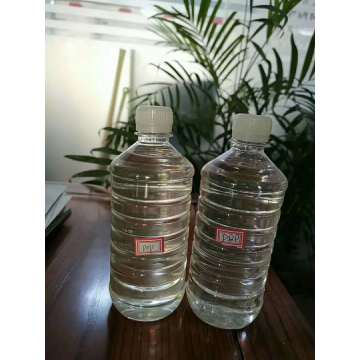
Privacy statement: Your privacy is very important to Us. Our company promises not to disclose your personal information to any external company with out your explicit permission.
![]() March 19, 2024
March 19, 2024


1、 The action and mechanism of plasticizers
Plasticizers refer to a type of substance that can improve the performance of polymers. Plasticizers are mainly used in PVC resins, and their dosage can account for more than 98% of the total Plasticizer dosage. The addition of plasticizers can reduce the interaction force between PVC molecular chains, resulting in a decrease in the glass transition temperature, flow temperature, and melting point of the microcrystals contained in PVC plastic. Plasticizers can improve the plasticity of the resin, making the product soft and resistant to low temperatures.
The effect of plasticizers on mechanical strength is not significant when the dosage is less than 10 parts. When about 5 parts of plasticizers are added, the mechanical strength is actually the highest, which is a so-called reverse plasticizer phenomenon. It is generally believed that the phenomenon of anti plasticization is the effect of adding a small amount of plasticizer, which increases the activity of large molecular chains and causes molecular ordering to produce microcrystals. The impact strength of hard products with a small amount of plasticizer added is actually smaller than that without added time, but when it is increased to a certain dosage, its impact strength increases with the increase of dosage, meeting the universal law. In addition, adding plasticizers reduces the heat and corrosion resistance of the product. For every additional part of plasticizer, Martin's heat resistance decreases by 2-3. Therefore, generally hard products do not add plasticizers or add less plasticizers. Sometimes a few plasticizers are added to improve processing fluidity. Soft products, on the other hand, require the addition of a large amount of plasticizer, and the higher the plasticizer dosage, the softer the product will be.
The total amount of plasticizers should vary according to the requirements for the softness of the product, as well as different uses, processes, and usage environments. The general rolling process for producing PVC films requires a total amount of plasticizer of about 50 parts. Blow molded film is slightly lower, usually between 45-50 parts.
The main functions of plasticizers are as follows:
1) Reduce the melting temperature and viscosity of the polymer, thereby lowering its molding and processing temperature;
2) Make polymer products soft, elastic, and resistant to low temperatures.
The polarity of plasticizers and resins is different, and their mechanisms of action are also different.
1) The volume effect is mainly related to non-polar plasticizers, which act by inserting them into the middle of the molecular chains of the resin, increasing the distance between molecules, thereby weakening the intermolecular forces, reducing the melt viscosity, and increasing the flexibility of the molecular chains. The more amount of such plasticizers are added, the greater the volume effect, and the volume effect of long-chain shaped plasticizers is greater than that of ring-shaped plasticizers.
2) The shielding effect is mainly aimed at polar plasticizers. Its mode of action is to replace the polar attraction between polymer molecules with the interaction between polar plasticizers and polar polymers, thereby weakening the intermolecular forces. This plasticizing effect is called the shielding effect.
2、 Performance of plasticizers
The performance of plasticizers mainly includes the following aspects: plasticizing efficiency, compatibility, cold resistance, durability, heat resistance, insulation, flame retardancy, and hygiene.
2.1 Plasticization efficiency
The plasticizing ability or effect of plasticizers on polymers, and the plasticizing efficiency of different plasticizers is a relative concept. The plasticizing efficiency is generally evaluated by the amount of plasticizer required to change the quantitative flexibility index. The less plasticizer added, the higher the plasticizing efficiency. A general molecular weight plasticizer has a higher plasticizing efficiency for PVC than a high molecular weight plasticizer. However, as the polarity of the plasticizer molecule increases, the degree of alkyl branching and aromatic ring structure increase, both of which lead to a decrease in plasticizing efficiency.
The order of plasticizing efficiency of commonly used plasticizers is: DBS>DBP>DOS>DOA>DOP>DIP>M-50>TCP>PCl-50.
2.2 Compatibility
It refers to the compatibility between plasticizers and polymers, and the same plasticizer has different compatibility with polymers of different polarities.
The compatibility order between commonly used plasticizers and PVC is: DBS>DBP>DOP>DIOP>DNP>ED3>DOA>DOS>chlorinated paraffin.
2.3 Cold resistance
Refers to the low temperature resistance of plasticizer plasticized products. The cold resistance of plasticizers is related to their structure. Aliphatic binary esters with methylene (- CH2-) as the main component have the best cold resistance and are the most commonly used type of cold resistant plasticizers. However, plasticizers with cyclic and branched structures have difficulty moving in polymers at low temperatures, which affects their cold resistance.
The cold resistance order of commonly used plasticizers is: DOS>DOZ>DOA>ED3>DBP>DOP>DIP>DIDP>DNP>M-50>TCP.
2.4 Durability
The ability of plasticizers to persist in plasticized products. Mainly including resistance to migration, extraction, and volatility.
2.5. Migration resistance
The migration of plasticizers includes two aspects: first, the plasticizer seeps out from the inside of the product to the outer surface; The second is the transfer of plasticizers to the solid in contact with them. The migration of plasticizers is related to their compatibility, and the poorer the compatibility, the greater the migration. In addition, plasticizers with high molecular weight and containing branched or cyclic structures have good migration resistance.
2.6. Extraction resistance
The tendency of plasticizers to diffuse into the liquid medium in contact with them. The media mainly include water, solvents, detergents, and lubricating oil. In terms of oil and solvent resistance, plasticizers with a higher proportion of non-polar alkyl groups have poor extraction resistance, while plasticizers with higher levels of phenyl, ester, and branching have better extraction resistance; However, water resistance is exactly the opposite of the above, and polyester is a plasticizer variety with excellent extraction resistance.
2.7. Volatility resistance
The tendency of plasticizers to diffuse into the air from the surface of the product when heated. The volatility of plasticizers is related to their molecular weight, and generally, the smaller the molecular weight, the greater the volatility. From a molecular structure perspective, straight chain alkyl structure plasticizers have better volatility resistance than branched chain alkyl structure plasticizers; Plasticizers containing large volume groups such as rings within the molecule have good volatility resistance. Plasticizers such as polyester, epoxy, DIOP, TCP, and pentaerythritol generally have good volatility resistance.
2.8 Insulation
The insulation performance of plasticizers is not as good as that of PVC Resin. As the amount of plasticizer added increases, the electrical insulation performance of PVC decreases. When selecting plasticizers for PVC insulation products, attention should be paid to their insulation properties. The insulation order of commonly used plasticizers is: TCP>DNP>DOP>M-50>ED3>DOS>DBP>DOA.
2.9 Hygiene
Refers to the toxicity of plasticizers. Most plasticizers are non-toxic or low toxicity, epoxy and Citric Acid esters are non-toxic plasticizers, benzoic acid esters and dicarboxylic acids are low toxicity plasticizers, but DOP and DOA are suspected to be carcinogenic; Phosphate plasticizers are mostly toxic, with the exception of diphenyl 2-ethylhexyl phosphate; Chlorinated paraffin is also a toxic plasticizer.
2.10 Flame retardancy
Phosphates and chlorinated paraffin belong to flame retardant plasticizers, and their flame retardancy order is: TCP>TPP>TOP>DPOP.
3、 Common plasticizer varieties and performance characteristics
There are many types of plasticizers, which can be divided into two categories based on their compatibility with polymers: main plasticizers and auxiliary plasticizers.
The main plasticizers include phthalates and phosphates, while the auxiliary plasticizers include aliphatic dicarboxylic acid esters, epoxides, bioplasticizers, etc.
According to the structural classification of plasticizers, they can be divided into: phthalates, aliphatic dicarboxylic acid esters, epoxides, polyesters, etc.
Di (2-ethylhexyl) phthalate (DOP) has high plasticizing efficiency and good comprehensive properties such as volatility resistance, migration resistance, water extraction resistance, and weather resistance. Production of soft PVC calendered agricultural film, with DOP as the main plasticizer and di (2-ethylhexyl) adipate (DOA) as the cold resistant plasticizer. Epoxy fatty acid ester plasticizers have good thermal stability and cold resistance, and commonly used varieties include 2-ethylhexyl epoxy stearate and 2-ethylhexyl epoxy soybean oleate.
High barrier polyvinylidene chloride (PVDC) film for food packaging requires the addition of an appropriate amount of 8-10 phr non-toxic plasticizer. The main varieties include tributyl acetylcitrate, tris (2-ethylhexyl) acetylcitrate, di (2-ethylhexyl) sebacate (DOS), etc. These plasticizers are also commonly used non-toxic plasticizers for PVC.
4、 The application of commonly used plasticizers in the flooring industry
4.1 Application of plasticizers in the wear layer of PVC flooring
The plasticizer DOTP is often used in PVC wear-resistant layers. Currently, the technology of this product is very mature. However, with the increasingly severe internal competition in the flooring industry, the pressure to reduce costs is increasing. Therefore, new plasticizers with cost advantages are gradually replacing DOTP. From partial substitution to 100% substitution, the cost of transparent fabrics in wear-resistant layers is greatly reduced, Roughly estimated, each ton of wear-resistant layer formula can save about 1000 yuan. Speaking of which, if there is a need for technical consultation in this area, enterprises that require DOTP as an alternative plasticizer and wear resistant layer cost reduction can contact me via private message.
4.2 Application of plasticizers in LVT elastic flooring
In addition to the PVC wear-resistant layer mentioned above, the second most widely used flooring industry should be in soft PVC flooring, also known as LVT flooring, commonly known as dry back. The addition of plasticizers can significantly improve the hardness and toughness of the product. Of course, adding a large amount of plasticizers can also have some effects, such as the floor being sensitive to temperature changes in the production process, leading to problems such as S-bends and banana bends in the product; Another issue is that during long-term use of flooring, there may be shrinkage and warping of the floor due to the volatilization and migration of plasticizers.
4.3 Application of plasticizers in SPC flooring
The application of SPC in hard flooring is relatively rare, but a small amount can be added to achieve unexpected results. If you need technical support, you can contact our editor privately.
The above is the Main Introduction to PVC plasticizers we have listed for you. You can submit the following form to obtain more industry information we provide for you.
You can visit our website or contact us, and we will provide the latest consultation and solutions
Send Inquiry
Most Popular
lastest New
Send Inquiry
Send Inquiry

Ms. Carlee
Tel:+86-371-86550988
Fax:
Mobile Phone:+8615515513998
Email:sales@chuangegroup.com
Address:RM24002,HANHAIBEIJIN BUILDING A, NO.73 BEISANHUAN ROAD,, Zhengzhou, Henan
Related Products List
Mobile Site


Privacy statement: Your privacy is very important to Us. Our company promises not to disclose your personal information to any external company with out your explicit permission.

Fill in more information so that we can get in touch with you faster
Privacy statement: Your privacy is very important to Us. Our company promises not to disclose your personal information to any external company with out your explicit permission.